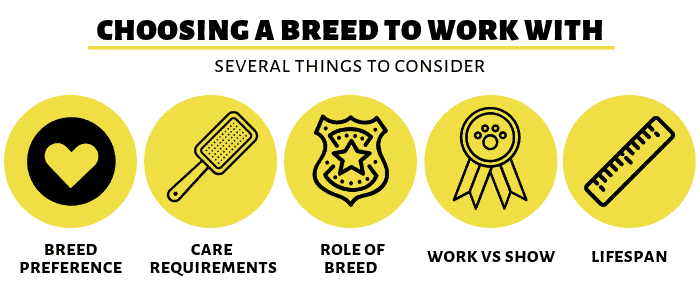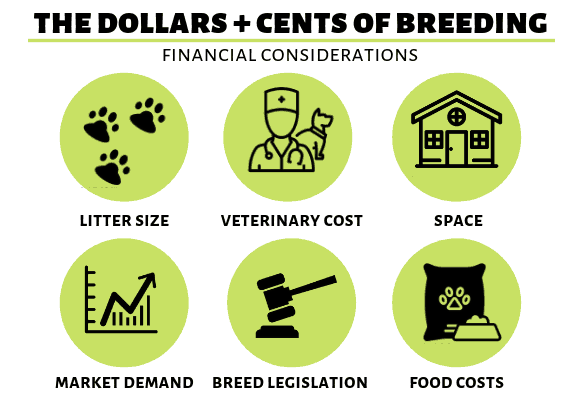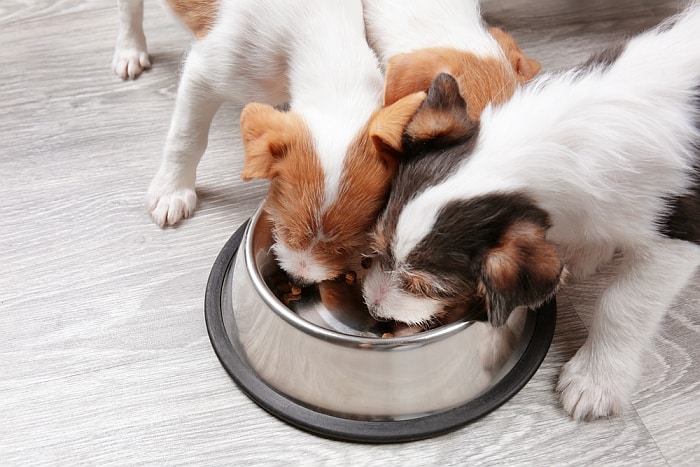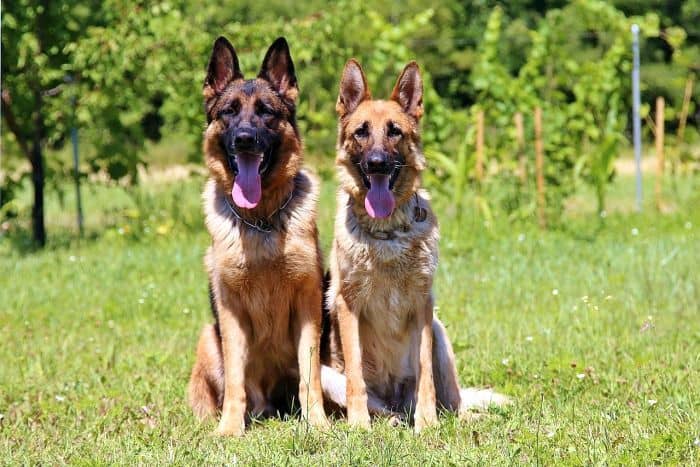Many dog owners consider breeding dogs to put a few extra dollars in their pocket.
However, becoming a dog breeder is not an endeavor to take lightly, and most people who consider the notion should probably dispel the thought.
Nevertheless, if you take good care of your canines, devise a coherent business plan and work hard, dog breeding can be a profitable venture. But you must start by picking a good breed to work with.
Simply put, some breeds will generate larger profits than others.
If you’re looking for quick picks, we have them right here! Or keep reading to learn the basics of starting a breeding business and why these pups fetch such a high price.
- Samoyed ($4,000 – $11,000)
- Pharaoh Hound ($2,500 – $6,000)
- French Bulldog ($1,500 – $8,000)
- Tibetan Mastiff ($2,000 – $5,000)
- Akita ($1,000 – $4,000)
- Saluki ($2,000 – $4,000)
- Otterhound ($1,500 – $2,500)
- Rottweiler ($2,000 – $7,000)
- English Bulldog ($2,000 – $4,000)
- German Shepherds ($1,500 – $7,500)
We’ll talk about some of the best dogs to breed and sell below, discuss some of the things you’ll need to consider when making your choice, and provide a few tips for selecting a breed that you’ll enjoy working with.
But first, let’s address the 800-pound gorilla waiting feverishly to join the conversation.
Adoption Isn’t Always the Best Option
There are millions of shelter dogs currently waiting for some loving soul to rescue them and give them a forever home.
Approximately 3.3 million dogs enter shelters each year, according to the American Society for the Prevention of Cruelty to Animals (ASPCA).
(Insert Sarah Mclaughlin song here.)
This is understandably heartbreaking, and it has led many dog-lovers to pressure new owners into adopting, rather than purchasing, their next pet. Let’s be clear: This type of advocation comes from well-meaning people, and it is expressed on behalf of the good floofs patiently waiting in shelters across the country.
But adopting a shelter dog is not always the best option. Hold on to your hate mail and hear me out:
I wholeheartedly encourage every prospective owner to consider adoption.
I have adopted shelter dogs in the past, and I’ll surely do so again in the future. I’ll eventually end up purchasing a big piece of land, and you better believe that there will be a pack of shelter dogs living with me and protecting our land from nefarious squirrels.
However, I handed over a pretty penny to a breeder for my current pup, and I’m glad I did. I knew exactly what I wanted, and a Rottie fit the bill perfectly. Not only that, but the specific Rottmonster I selected had all of the specific traits I was looking for: She was self-assured and confident, her mother was very friendly, and she began bonding with me instantly.
She was a pretty cute little bugger too:

Don’t get me wrong, you can end up with an amazing rescue dog from a shelter. But if there are certain needs or qualities you are looking for in a dog, a breeder is often your best bet.
I wouldn’t have necessarily been able to meet my dream-dog checklist by adopting a shelter dog. And for a variety of reasons, many others will find themselves in a similar situation.
In such cases, there is nothing wrong (in my view) with purchasing a dog from a breeder, instead of adopting a dog from a shelter or rescue.
So, definitely consider adoption, but don’t feel bad for purchasing a dog from a reputable breeder, if it is a better choice for you and your family.
A Brief Personal Note
I’ve raised a few dog litters over time, but I’ve never bred dogs for profit.
However, before moving behind a computer full-time, I spent my adult life working with a diverse array of animals. And for a decade and change, I supplemented my income by selling captive-bred reptiles.
Obviously, reptiles are very different from dogs, but from a 30,000-foot perspective, the pursuits have plenty in common.
I’ll try to share some of the things I learned when breeding scaly critters dogs below – especially those things that are applicable to canine-oriented breeders.
First Thing’s First: Be Clear About Your Dog Breeding Goals
You’ll need to begin your dog-breeding foray by deciding exactly what it is you intend to accomplish.
- Are you simply in love with a given breed and want to breed them for fun?
- Are you passionate about a particularly rare breed and want to help increase the existing population?
- Or is your primary motivation financial?
These are all perfectly valid reasons for initiating a breeding project, but they’ll each influence your decisions and game plan moving forward. To have the best chance of successfully reaching your goals, you’ll need to keep your primary goal in mind when making decisions.
This isn’t to say that you can’t have multiple reasons for breeding dogs. You may, for example, be interested in turning a profit, but also be incredibly passionate about the breed you choose.
But no matter what your goals are, keep one thing in mind: The well-being of your animals must always be your first priority, and you should make every decision with them in mind.
Preliminary Breed Considerations: What to Think About When Choosing a Breed to Work With
There are a number of things you’ll want to think about before deciding which breed you want to work with.
You’ll obviously need to think about the financial ramifications of your choice (more on this later), but there are plenty of other factors to consider when making your selection.
Specifically, you’ll need to select a breed that works well for your personality and desires. While the financial factors we’ll discuss later will help determine how profitable a given breed will likely be, these considerations will help determine how much you enjoy breeding your pups. And let’s be honest, it’s hard to be good at something if you don’t even enjoy it.
Some of the most important things to think about include:

→ Your Breed Preferences
It isn’t imperative that you pick one of your favorite breeds to work with, but you’ll have a much better time caring for the adults and raising the ensuing puppies if you do.
Dog breeding requires an incredible amount of work, and you’ll end up spending hours each day with your canines – picking a breed you like will help keep a smile on your face while picking up poop and listening to puppies cry at 3:00 AM.
Don’t start breeding Chinese cresteds if you don’t like little dogs. Don’t decide to breed Great Danes if they make you nervous. Instead, pick a breed that you’d enjoy keeping even if you weren’t intending to breed them.
→ Care Requirements
Different dog breeds require different levels of attention from their owners.
Chows, for example, are independent dogs, who don’t need a lot of one-on-one time with their people. They also have relatively low exercise requirements. This means that you won’t have to spend hours every day throwing a ball and giving your chows lots of attention.
On the other hand, some breeds are typically quite needy and require plenty of attention from their people. Rottweilers, for example, are incredibly smart, easily frustrated dogs, who normally bond very strongly with their owners.
If you decide to breed Rotties, you’ll need to factor in several hours for play, training and praise each day.
Pick a high-maintenance breed if you like, but just be sure that you are willing to provide your animals with the things they need to enjoy a high quality of life.
→ The Typical Role of the Breed
You should also give some thought to the relationship your chosen breed typically has with their people.
For example, most people keep Cavalier King Charles Spaniels as pets – they aren’t used often by police departments or search-and-rescue teams. On the other hand, Belgian Malinois and bloodhounds frequently spend their lives as working dogs. Other breeds are often used in therapy or service contexts.

These types of considerations will influence the marketability of the dog, but it’s also important to think about from a conscience point of view.
You can be reasonably sure that working dogs will be well-treated by their handler or owner, but they may lead strenuous or even dangerous lives. Is this the kind of thing that would weigh on you? If so, you may want to stick to breeds that are typically kept as pets.
→ Work or Show?
Many dog breeds are represented by different sublineages. These different lineages or lines are descendants of the same original founding stock, but they exhibit subtle differences – differences that are the result of the conscious efforts of breeders.
Take Labrador retrievers, for example.
Some Labs are bred to retrieve birds for hunters, while others are bred to compete in dog shows (both types are kept as pets). Those in the former category are said to hail from “field lines,” while those in the latter represent “show lines.”

Labs from field lines tend to have much higher prey drives and energy levels, and they’re typically pretty tall and light on their feet. Conversely, show Labs are typically a bit calmer and more trusting of strangers, and they usually have a shorter, heavier build than their field-line counterparts (they also tend to be a much better fit for families).
Neither type of line is inherently better than the other, but you need to decide which one you would prefer to work with if the breed is represented by more than one genetic lineage.
Once again, it is typically wisest to select the one you’d most like to spend a lot of time with.
→ Lifespan
Different breeds typically live for different lengths of time. There are exceptions, but generally speaking, small breeds live longer than large breeds do.
Irish wolfhounds and Great Danes usually live about 7 or 8 years, but Chihuahuas and Shih Tzus usually live for 10 or 12 – some may even see their 15th birthday.
This issue has financial implications (you’ll end up feeding retired breeders and providing them with veterinary care for the rest of their lives), but the most important thing to consider is how this lifespan will affect you emotionally. Dogs who live for a shorter period of time due to short lifespans cause some owners considerable grief.
Just be sure to consider this when selecting a breed to work with.

The Dollars and Sense of Breeding: Six Financial Considerations
Now that you’ve thought about some of the broad criteria involved with selecting a breed, it is time to move on to the things that’ll affect your bottom line.
Hopefully, the preliminary considerations we’ve already discussed have helped you to narrow down your potential list to three or four possible choices. The following questions should help you whittle these down even further.
Note that the following considerations are very bottom-line oriented – they may even come across as a bit cold or uncaring. But if you intend to breed for profit, there is no way to get around these types of questions and issues.

1. Fecundity (Litter Size)
Litter size is one of the most critical factors in determining the profitability of a given breed. However, the issue is a little more nuanced than most would-be breeders initially understand.
At first glance, fecundity appears positively correlated with profit – but this doesn’t always turn out to be true.
Sure, you’ll make more money selling a dozen German shepherds than you will by selling two. But the funds you collect aren’t profit – they’re income. You’ll have to use a large portion of this money to cover the costs of caring for the puppies and their parents.
And in some cases, your profits will decrease with larger litter sizes.

For example, the more puppies you have, the more food you’ll need. You’ll also have to spend more on vaccinations, crates and chew toys, and you’ll spend more time caring for the individual puppies too.
These needs may all cost the same amount on a per-puppy basis, but collectively, the costs of meeting these needs may exceed the amount of cash you have on hand. Do you have a few thousand dollars laying around to support your puppies for 8 weeks before you can make your first sale?
It’ll also take you more time to find a dozen customers than it will take you to find three or four. This will increase the amount of money you’ll need to spend on food and veterinary care, and it’ll also take up more of your time.
If it takes you too long to find customers, you may even have to start reducing your asking price as the puppies age.
Finally, consider that the more puppies you have, the more likely one or more of them will suffer from serious (read: expensive) medical issues. If you have one puppy that requires surgery, you may end up losing money on the entire litter.
2. Veterinary Costs
No matter what breed you decide on, you’ll need to provide all of the veterinary care necessary for your adult breeding stock as well as their offspring for the first 8 to 12 weeks of life. This will always be a significant cost, but some breeds typically require more veterinary care than others.

Rottweilers get cancer more often than many other breeds. Both English and French bulldogs often suffer from respiratory conditions that require surgery to correct. Great Danes can be expensive to sell, but they’re susceptible to bloat, and German shepherds frequently experience digestive issues.
Some breeds even have characteristically complicated pregnancies. French bulldogs, for example, are often unable to give birth normally – most mothers will need a Caesarian section to deliver their puppies. Such procedures are not cheap, and they’re part of the reason that Frenchies are pretty pricey.
These issues will affect your bottom line, so you must consider veterinary care when picking the breed you want to work with.
3. Space
Different dog breeds require different amounts of space, so you must factor in your living situation when picking a breed.
You could probably raise a litter of pugs in a guest bedroom, but you’d never want to attempt the same thing with Great Danes or Newfoundlands. Instead, you’d probably want a dedicated room or building to house them.
A large yard will help provide some elbow room and running space for big puppies, but you don’t want to raise puppies outdoors. Doing so will expose them to myriad pathogens, which will not only lead to sick and miserable puppies, but to lost profits as well. Instead, you’ll always want to raise puppies indoors.
Simply put, if you have space limitations, you’ll likely want to stick with a small breed.
4. Demand and Market Saturation
Supply and demand are important forces in all markets and dogs are no exception. Breeds in low demand typically fetch relatively modest amounts of money, while breeds in higher demand command premium prices.
Lots of people want Samoyeds, so they’re pretty expensive. On the other hand, relatively few people want Chinese crested dogs (they’re definitely an acquired taste), so they are priced rather reasonably.
However, the relative availability of a breed also factors into this issue. Once again, let’s consider Labrador retrievers.
Labs are phenomenal pets, and they’re currently rated as the most popular breed by the American Kennel Club (AKC). But you don’t have to look very hard to find Lab puppies for sale – they’re everywhere. Accordingly, despite their considerable awesomeness, Labs are pretty affordable.
On the other hand, some breeds aren’t especially popular, but because they’re so rare, they are quite expensive.
Thai ridgebacks and Canadian Eskimo dogs are two good examples of high-priced dogs that are in relatively low demand.
Relatively few people have even heard of these breeds, so they don’t exactly “fly off the shelves.” But because they’re uncommon, breeders are able to sell them for significant sums.
5. Insurance and Breed-Specific Legislation
If your breeding project rises above the level of a hobby, you’ll have to think about obtaining an insurance policy to protect you from liability. Once again, the breed you select will influence this cost.

This isn’t usually a problem for those breeding small or medium-sized breeds. Instead, it is usually a problem for those who wish to work with giant breeds or those with aggressive reputations (regardless of the facts of the matter).
So, if you plan on breeding Rotties, Dobermans, pit bulls, Akitas, or any of the mastiff breeds, you’ll need to factor insurance costs into your decision.
And while we’re on the subject, you’ll want to consider the possibility that breed-specific legislation will shrink your customer base. Many municipalities are prohibiting some of these breeds (despite the complete lack of evidence regarding their efficacy), and you don’t want to decide to work with Presa Canarios, only to find them banned in your city at a later date.
6. Food Costs
Big dogs cost more to feed than smaller dogs do. You may only need a bag or two of food to keep a litter of Pomeranians fat and sassy, but you’ll need a truckload to keep your litter of Irish wolfhounds well fed.
This doesn’t always mean that large dogs are less profitable to feed than their smaller counterparts. Some large breeds command prices that are high enough to offset these increased food costs. But you’ll want to do the math and figure out how much your food bill will eat into your profits before making a choice.

Just be sure that you don’t skimp on food quality to try to increase your profits. Remember: The well-being of your dogs and puppies must be your primary concern. You may not need to purchase an exorbitantly expensive food, but you certainly want to ensure that your puppies and adults get the nutrition they need.
In fact, the food you feed your female breeders will have a very significant effect on their reproductive output.
High-Priced Hounds: Some of the Most Expensive Dog Breeds
Now that we’ve discussed some of the other factors you’ll need to consider when selecting a breed for your business, it is time to consider the typical price of various breeds.
We’ll provide the typical price range for each breed below, but, as you’ll surely notice, these prices vary pretty significantly. So, don’t be surprised to find individuals of these breeds with prices that are outside of the range provided. Just be sure that you consider all factors when selecting your breeding stock.
1. Samoyed ($4,000 to $11,000)

Samoyeds are gorgeous dogs with some of the most luxurious coats in the animal kingdom. These factors both help keep the price of Samoyeds high, but their coat also influences their cost in another way – relatively few breeders are willing to work with a breed that has such a high-maintenance coat.
Samoyeds are also susceptible to a kidney disease called Samoyed hereditary glomerulopathy. This disease – which doesn’t become apparent until the puppies are about 3 months old – causes many male Samoyeds to die at about 15 months of age.
This, combined with the small litter size of the breed (they typically give birth to two, three, or four puppies), keeps the supply of the animals relatively low, thereby increasing demand and their price.
2. Pharaoh Hound ($2,500 to $6,000)

Pharaoh hound photo from Wikipedia.
Pharaoh hounds are striking dogs who’ve likely been around for about 6,000 years.
Pharaoh hounds are sighthounds, like greyhounds, Salukis, and Afghan hounds, but they exhibit quite a few differences from these other breeds. For example, Pharaoh hounds are pretty vocal, unlike many of their sighthound cousins.
Pharaoh hounds are certainly beautiful dogs, but their high price tag is primarily a result of their rarity – there just aren’t many of them in the U.S. or Europe. In fact, pharaoh hounds only became known to westerners in the 1930s, and they only gained AKC recognition in 1984.
Additionally, pharaoh hounds are very sensitive to cold temperatures, which means that breeders living in cold regions rarely work with them. This also helps to keep them rather rare in the marketplace.
3. French Bulldog ($1,500 to $8,000)

French bulldogs are cute little canines, with gigantic ears and endearing personalities. Originally created to be toy-sized bulldogs, these little pups are loyal companions, who love nothing more than hanging out with their owner all day long.
Because they’re pretty neato little dogs, they are in high demand, which keeps their price high. However, their high price also reflects a few unfortunate realities.
For example, more than 80% of French bulldogs are born via Caesarian section. Such procedures cost a lot of money, and these prices are passed along to those buying these little dogs.
Additionally, French bulldogs also suffer from a variety of health problems, including eye problems, spine problems, and breathing difficulties. They also have relatively few puppies at a time and live shorter lives than many other small breeds. All of these things reduce the number of Frenchies running around.
4. Tibetan Mastiff ($2,000 to $5,000)

Tibetan Mastiff photo from Wikipedia.
Tibetan mastiffs are some of the biggest dogs in the world, and their incredibly long and thick coats make them look even bigger than they are. Weighing up to 150 pounds and full of courage, these dogs were initially developed to guard their owners and livestock in the snowy Tibetan mountains.
There are a variety of reasons why Tibetan mastiffs are such expensive dogs. For starters, they haven’t been common in the U.S. or Europe for very long – they only gained AKC recognition in 2007. There aren’t many purebred Tibetan mastiffs around, either. The vast majority of dogs that resemble Tibetan mastiffs have mixed ancestry.
Additionally, Tibetan mastiffs are currently considered a bit of a status symbol in some parts of Asia (particularly China). This means that breeders are able to charge very high prices for their puppies. In fact, some have reportedly sold for seven-figure sums.
5. Akita ($1,000 to $4,000)

Like Samoyeds, Akitas are gorgeous animals with luxurious coats. However, unlike Samoyeds, who are typically playful, mischievous and fun-loving, Akitas are all business.
Originally bred for guard-dog work, Akitas are some of the bravest and most unflinchingly protective dogs around. And while exceptionally loving, affectionate and loyal with their families, Akitas tend to be very suspicious of strangers. They can also be prickly with other dogs – particularly those of the same sex.
Accordingly, Akitas aren’t appropriate for a lot of families – especially those who’ve never kept a big, assertive dog before. This effectively shrinks the market for the breed, which also reduces the number of breeders who work with them.
Ultimately, this means that those who do want an Akita have relatively few places from which they can be purchased.
This, in turn, means that breeders can often charge high prices for their puppies.
6. Saluki ($2,000 to $4,000)

Salukis are beautiful sighthounds who love doing two things in life: Lounging on the couch with their owner and running at warp speed – especially in pursuit of prey. The Saluki is an old breed; archaeologists have found artwork featuring dogs that resemble Salukis dating back more than 4,000 years.
The high price of Salukis is due to a combination of factors. First of all, the breed is relatively rare, so there just aren’t that many of them around. Additionally, they’re somewhat high-maintenance dogs, who require a fair bit of coddling to remain healthy and happy.
Salukis are also susceptible to several congenital health problems, so breeders are forced to pay for an array of genetic tests (these prices are then passed on to buyers).
7. Otterhound ($1,500 to $2,500)

Otterhound photo from Reddit.
The Otterhound is a goofy and lovable dog with one of the highest energy levels of any breed. Friendly and affectionate with just about everyone, the shaggy otterhound tends to get along well with strangers, kids, and other pets.
These traits make the dogs quite desirable, but unfortunately, they’re exceedingly rare. According to some estimates, fewer than 500 individuals currently live in the U.S., and you can count the number of litters born each year on one hand.
This rarity means that breeders are able to charge high prices for their puppies. It also means that most people who want to add an otterhound to their family will need to sign up for a waiting list – it’s rarely possible to find puppies for sale otherwise. We actually looked around a bit and were unable to find any for sale at all.
8. Rottweiler ($2,000 to $7,000)

Despite being more common than some of the other dogs on our list, Rotties are also pretty expensive pups. But unlike some of the other breeds on our list, it’s not entirely clear why they are. In fact, many of their traits should reduce their demand, which should result in lower prices.
Rottweilers are certainly some of the most attractive dogs around, and they’re also intelligent, loyal, and affectionate with their people. You’d expect to find these types of traits in high-priced dog breeds.
However, they are a bit more dog than a lot of people want, they aren’t a good choice for first-time owners, and they are targeted by breed-specific legislation in some places. These factors should all reduce their demand and price. Rottweilers are also prone to a number of health problems, and they require a ton of space, attention, and food.
Frankly, their high price is a bit puzzling, but as far as I’m concerned, they’re worth every penny in your pocket.
9. English Bulldog ($2,000 to $4,000)

The English bulldog is one of the most instantly recognizable breeds in the world. Short, stocky and a bit sluggish, these cute little dogs are very entertaining to watch as they try to make their way in the world.
But while bulldogs (the “English” portion of their name has officially been dropped, but we still use it to distinguish them from American bulldogs) can make loving and affectionate pets, they often experience an array of health problems. These health problems eat into the profits of breeders, who then pass these costs on to consumers.
Most bulldogs are born via Caesarean section, and they frequently suffer from hip problems and breathing difficulties. These factors mean that the demand for the dogs often exceeds the supply, thereby keeping the price of these little waddlers high.
10. German Shepherds ($1,500 to $7,500)

German shepherds are incredibly popular (the AKC lists them as the second most popular breed in the U.S.) and well-behaved dogs, who are famous for their intelligence and impressive abilities. They’re affectionate, friendly, loyal and protective – everything most people would want in a dog.
This popularity influences the price of German shepherds in somewhat unusual ways. Unlike some of the other dogs on our list, German shepherds occasionally command very prices, but you can also find them for relatively modest sums.
This is because German shepherds are rather common, so the market for them is somewhat saturated, which keeps their prices relatively low. Some breeders have to offer their puppies for low prices in order to sell them all.
On the other hand, many buyers are willing to pay very high prices for puppies that descend from award-winning bloodlines.
How to Be a Responsible Dog Breeder
Starting any business is exciting stuff. But breeding dogs (or any other animal, for that matter) is different than deciding to start a photography business or internet marketing agency.
If you fail in one of the latter examples, you’ll lose a bit of money and some time, but that’s about it. You can dust yourself off, think up another business and try again.
But breeders are responsible for the well-being of their animals. Fail as a breeder and you won’t only lose time and money, your animals may suffer too. These are living, breathing, feeling beings, who deserve the best quality of life possible, and you simply cannot allow them to languish in your care.
Accordingly, you’ll need to spend a little more time and energy thinking about being a breeder than launching a new website. This means, among other things, doing the following:
Establishing a relationship with a veterinarian. As a breeder, you’ll need veterinary assistance on a pseudo-constant basis. Not only will your adult breeders need veterinary care from time to time, the puppies you produce will need lots of care (including your pup’s vaccinations) too. Whenever possible, try to forge a relationship with a vet that will come to your location, so you don’t have to drag a wheelbarrow full of babies into the office every few weeks.
Setting up a place for your dog’s and puppies to live. Don’t just expect your dogs and puppies to live in the house with you. You may allow them to wander the house during brief periods of time, but you’ll need to set up a safe place for them to live when you can’t watch them. Minimally, this means you’ll need an indoor space that can accommodate suitably spacious kennels for all the puppies. You’ll likely want some nice outdoor kennels as well to allow your pups to play outside safely.
Setting aside emergency funds to finance unforeseen problems. Whether you are breeding dogs or simply a pet owner, you must be prepared for unexpected problems – chiefly those of a medical variety. Because you’ll be caring for a significant number of dogs, breeders are more likely to need “rainy day” money than owners will.
Having all of your breeding stock (and the puppies they produce) screened for common health problems. You must not breed animals that have hereditary health problems. Doing so will only bring pain and suffering to more puppies and their owners. Different breeds will require different types of screening, so be sure to research the typical health problems of the breed you select.
Figuring out how to make time to provide for the needs of the dogs. Many would-be breeders find it difficult to make time to tend to their dogs and puppies. This primarily occurs because they fail to appreciate just how much time it takes to provide the type of care dogs need. You’ll need to make time to feed, water and walk them, as well as take them to the vet, clean their quarters, and have them groomed (if necessary).
Designing a sales protocol that ensures your puppies end up in good homes. Your work as a breeder isn’t done once you collect a check. You’ll have to continue to provide guidance to the new pet parents, and from time to time, you may have to take a dog back, if things don’t work out. Accordingly, you’ll need to devise a fair sales protocol, that addresses things like refunds, how clients meet the animals, and what type of paperwork and health certificates you’ll provide with the puppies.
Researching the legal requirements to breed dogs in your area. It isn’t legal to breed dogs in all places – some cities and towns ban the practice outright. Additionally, you may need to obtain licenses to become a breeder, depending on your location and the scope of your work. There’s no quick-and-easy way to do this, you’ll just have to start researching the relevant laws in your area.
Breeding dogs is a significant undertaking, so it isn’t something to decide to do on a lark. However, if you develop a good plan, think carefully about the breed you wish to work with, and – most importantly – take the best possible care of your breeders and their puppies, you can make a few bucks while working with some incredible animals.
Best of all, you’ll get to play a role in forging new pet-owner bonds while doing so. And as I’m sure our readers will agree, there are few better things in the world than the love of a good dog.
Incidentally, if you haven’t already done so, be sure to check out Kayla’s excellent article about finding a good breeder. This piece is aimed at prospective pet owners, but it will be very helpful for those who are considering breeding dogs too.
Have you ever bred dogs for profit? Share your experiences with us! What breed did you work with? Did they turn out to be profitable? What advice would you give would-be breeders about picking a breed?
Let us know in the comments below!








Leave a Comment